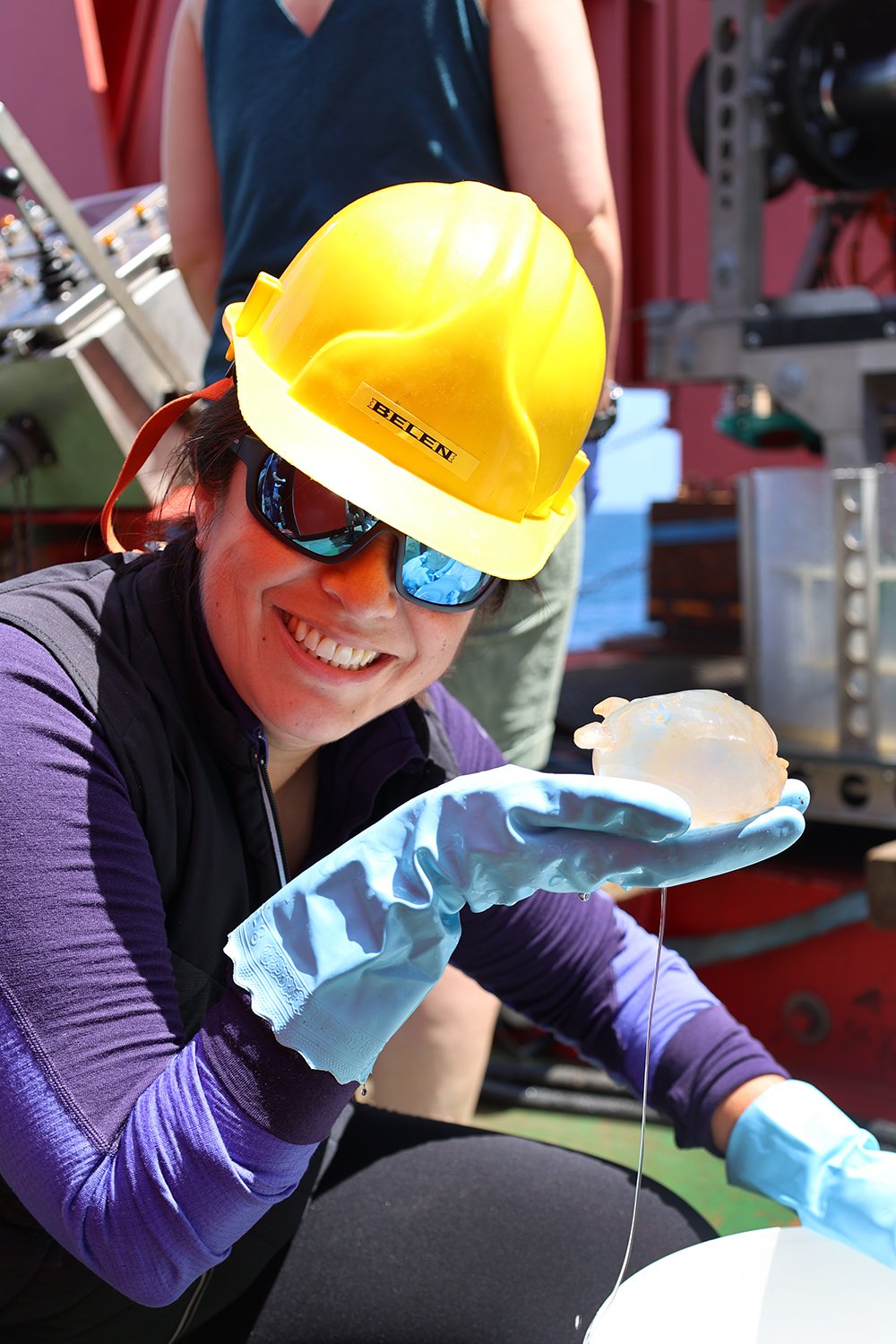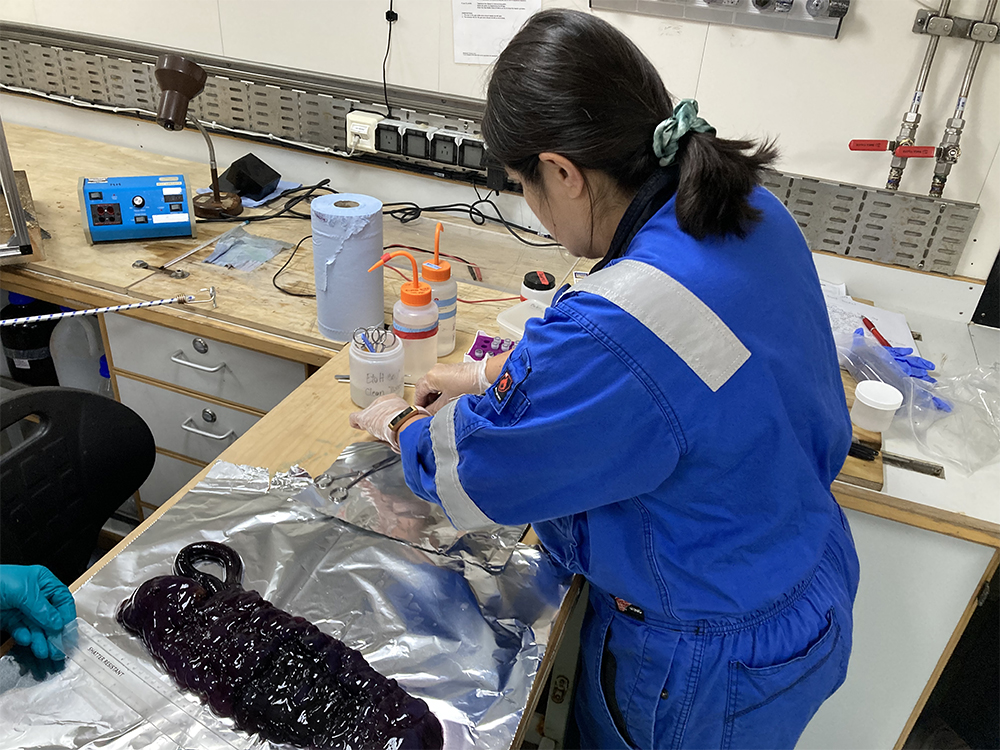From a molecular laboratory to deep-sea expeditions: How can genomics help us assess connectivity of deep-sea species?
By Dr Belen Arias, Natural History Museum
When I was offered [the opportunity] to join the SMARTEX project I had mixed feelings. I was delighted to be involved in such an incredible project spanning multiple disciplines but, at the same time, I was concerned about how my experience in a controlled environment such as a molecular laboratory would transfer to an unpredictable area like a deck lab on a scientific cruise.
My work experience is in molecular ecology. I use DNA, RNA, protein expression, and microbiome to answer questions related to adaptation, evolution, and biogeography. Previously, I have worked with harbour seals, mussels, sponges, and corals. These animals were collected anywhere from intertidal zones to deep waters (0 to 2,000m). On the majority of these projects, I was not involved in collection, instead using samples in the molecular lab to assist with taxonomic identification, perform molecular extractions, library preparation for next generation sequencing (NGS) and posterior bioinformatic analyses.

For the past five weeks, I have been directly involved in the selection of candidate animals to perform molecular connectivity studies in the Clarion-Clipperton Zone (CCZ) in the northeast Pacific. This is an area with abundant polymetallic nodules in the seafloor, with potential mining interest. Currently, we have an understanding about the abundance and species distribution that inhabit this abyssal plain. We are also aware of the potential effects on benthic communities that mining exploitation might produce in the region, but unfortunately, after decades of research in this region, little is known about the biogeography and connectivity of the species that inhabit deep-sea realms.
To efficiently protect the biodiversity in the deep-sea, it is essential to understand the connectivity at the species level spanning a great diversity of taxa, their population extent, and linkages across marine realms. Unfortunately, due to the remoteness and wide range of the CCZ, this information remains unknown for most of the animals that inhabit the region. However, with the development and use of ’omics methods we can start to reduce this knowledge gap. To date, there is only one study that uses microsatellite to assess the genetic diversity and connectivity of a sessile sponge, Plenaster craigi, in the CCZ.
Currently, modern molecular methods are particularly robust in providing suitable genomic data for population genomic studies. These methods require high molecular weight, and ideally non-degraded DNA which is notoriously challenging to extract from some deep-sea animals and tissue types (i.e., crustacean and echinoderms with exoskeletons). Additionally, the feasibility of collecting the minimum number of individuals needed to draw robust conclusions is unpredictable in this remote environment. For this reason, we treat each specimen as a precious and unique resource of information. Once we collect samples, the time taken to process and transport them back to the molecular lab exhibits a great many stressors on the samples (i.e., changes in temperature, pressure, salinity, etc.) that can affect the DNA preservation. For this reason, temperature and time are kept under constant surveillance while processing the samples on deck.
This is my first experience collecting samples at sea, and I have tried to incorporate my laboratory logistics into this new working environment. For instance, we try to keep the specimens in individualised clean buckets to minimise cross contamination. The significant pressure and temperature changes that samples experience on their way up from the deep (~4,700m) can greatly affect body structure. Therefore, samples are often extremely fragile, which makes processing a delicate and complicated operation.

Once the animals are in the deck lab, we examined taxonomical characters for identification and took voucher pictures, taking care to be as clean as possible. Then, those genomic connectivity target species were dissected in the cold room at 4°C. The dissection area and instruments were treated with bleach at 1% to prevent DNA contamination. The dissection helps us to have clean samples and a good amount of tissue that is preserved in different fixation methods. On board the RRS James Cook, we have a variety of equipment that supports preservation of samples for molecular purposes. We are fortunate to have liquid nitrogen, so as soon as the tissue is obtained, we can flash freeze it and store it at −80°C for the rest of the expedition. This preservation method alone may be enough to obtain the entire genome of this specimens, something I must evaluate once we arrive to the molecular lab at the Natural History Museum.
Other tissues are also preserved in different fixation methods to gather information about questions related to microbiome associated with different tissues, reproductive strategies, or genes expression. Each dissection that I performed gave me new insights into these elusive animals, such as the existence of parasitic snails living inside a species of sea cucumber. I believe that all the methods implemented in the sample collection and processing will provide enough material to perform population genomic studies.
We are planning to use different ’omics sequencing methods to obtain genomic markers in the order of hundreds to thousands. This information will facilitate the exploration of genomic differences among samples and to determine whether the organisms at the sampling site constitute a discrete or panmictic population. At the same time, we will be able to establish degrees of genomic connectivity or isolation among the surveyed samples. The results of this expedition will further the current CCZ metazoan baseline and provide stakeholders with valuable information. Knowing how deep-sea populations are connected is essential in designing effective conservation policies and enhance our understanding of life in the deep.
Glossary
Microsatellite: few genetic markers across the genome that are polymorphic enough to provide genetic patterns.
References
- Taboada, S., Riesgo, A., Wiklund, H., Paterson, G.L.J., Koutsouveli, V., Santodomingo, N., et al., 2018. Implications of population connectivity studies for the design of marine protected areas in the deep sea: An example of a demosponge from the Clarion-Clipperton Zone. Mol Ecol. 27(23): 4657–79.
- Jenkins, T.L., Stevens, J.R., 2018. Assessing connectivity between MPAs: Selecting taxa and translating genetic data to inform policy. Marine Policy 94: 165–73.
- Taylor, M.L., Roterman, C.N., 2017. Invertebrate population genetics across Earth’s largest habitat: The deep-sea floor. Mol Ecol. 26(19): 4872–96.